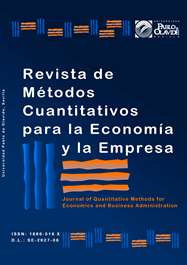Modelos de Riesgo de Crédito: aplicación práctica a un modelo de refinanciación de hipotecas
DOI:
https://doi.org/10.46661/revmetodoscuanteconempresa.2976Palabras clave:
riesgo de crédito, optimización, programación dinámica, tipo de interés, refinanciación hipotecaria, valores respaldados por hipotecas, Basilea IIIResumen
Ante un hipotético, pero cada vez más real, caso de riesgo de impago de una hipoteca o ante una caída en los tipos de interés, un asunto importante que se plantea el prestatario es el de la posibilidad de minimizar ese riesgo mediante la selección de la mejor opción de refinanciación. En el presente trabajo se presenta un modelo de refinanciación de hipotecas desarrollando un método de programación puramente cuantitativa, con una simulación basada en un algoritmo creado especialmente para este caso y que puede ser útil para deudores hipotecarios. Así, se comienza explicando la base teórica sobre la que se asienta la investigación, para pasar a desarrollar el problema, continuando con su implantación. Finalmente, se analizan los resultados y se comentan las conclusiones más relevantes.
Descargas
Citas
Campbell, J.Y. (2012). Mortgage Market Design, NBER Working Paper, nº w1939.
Capuano, C. (2008). Recent Advances in Credit Risk Modelling, IMF Working Paper.
Hannoun, H. (2010). The Basel III Capital Framework: A Decisive Breakthrough. BoJ-BIS high Level Seminar on "Financial Regulatory Reform: Implications for Asia and the Pacific", Hong Kong SAR, 22 November 2010.
Kalotay, A.J., Yang, D., & Fabozzi, F.J. (2008). Optimal Mortgage Refinancing: Application of Bond Valuation Tools to Household Risk Management. Applied Financial Econometric Letters, 4, 141-149.
Longstaff, F.A. (2005). Optimal Recursive Refinancing and the Valuation of Mortgage-Backed Securities. Real Estate Economics, 33(4), 619-661.
Pliska, S.R. (2006). Mortgage Valuation and Optimal Refinancing. Stochastic Finance, Springer.
Rasmussen, K.M., Madsen, C.A., & Poulsen, R. (2014). Can Home Owners Benefit from Stochastic Programming Models? - A Study of Mortgage Choice in Denmark. Computational Management Science, 11(1), 5-23.
Roncoroni, A., & Moro, A. (2006). Flexible-Rate Mortgages. International Journal of Business, 11(2), 143-157.
Roncoroni, A., & Fusai, G. (2008). Implementing Models in Quantitative Finance: Methods and Cases, 2nd ed, Springer.
Sy, W. (2008). Credit Risk Models: Why They Failed in Credit Crisis. Australian Prudential Regulation Authority (Sydney).
Tai, L.S., & Przasnyski, Z. H. (2000). Evaluating Refinancing Strategies Precisely. Journal of Financial and Strategic Decisions, 13(3), 9-21.
Walter, S. (2010). Basel III and Financial Stability. 5th Biennial Conference on Risk Management and Supervision. Financial Stability Institute, Bank for International Settlements, Basel, 3-4 November 2010.
Publicado
Cómo citar
Número
Sección
Licencia
Derechos de autor 2019 Revista de Métodos Cuantitativos para la Economía y la Empresa

Esta obra está bajo una licencia internacional Creative Commons Atribución-CompartirIgual 4.0.
El envío de un manuscrito a la Revista supone que el trabajo no ha sido publicado anteriormente (excepto en la forma de un abstract o como parte de una tesis), que no está bajo consideración para su publicación en ninguna otra revista o editorial y que, en caso de aceptación, los autores están conforme con la transferencia automática del copyright a la Revista para su publicación y difusión. Los autores retendrán los derechos de autor para usar y compartir su artículo con un uso personal, institucional o con fines docentes; igualmente retiene los derechos de patente, de marca registrada (en caso de que sean aplicables) o derechos morales de autor (incluyendo los datos de investigación).
Los artículos publicados en la Revista están sujetos a la licencia Creative Commons CC-BY-SA de tipo Reconocimiento-CompartirIgual. Se permite el uso comercial de la obra, reconociendo su autoría, y de las posibles obras derivadas, la distribución de las cuales se debe hacer con una licencia igual a la que regula la obra original.
Hasta el volumen 21 se ha estado empleando la versión de licencia CC-BY-SA 3.0 ES y se ha comenzado a usar la versión CC-BY-SA 4.0 desde el volumen 22.










